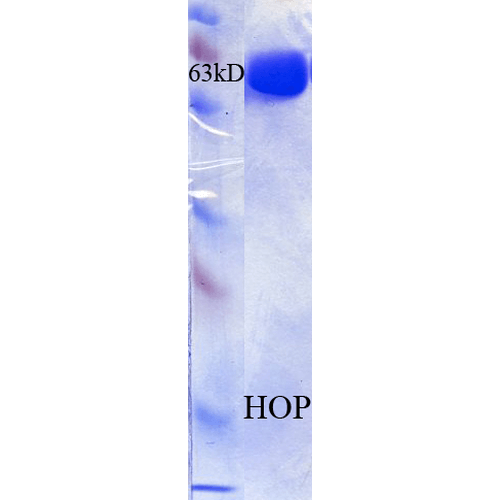SPR-302A SPR-302B
Scientist.com Supplier
HOP Protein
Stressmarq Biosciences
DESCRIPTION
Human Recombinant HOP Protein
DETAILS
- Nature: Recombinant
- Purity: >90%
- Target: HOP
- Category: Protein
- Conjugate: His tag
- References: 1. Flom G., Behal R.H., Rosen L., Cole D.G., Johnson J.L. (2007) Biochem J. 404(1): 159-167. 2. Harst A., Lin H., Obermann W.M. (2005) Biochem J. 387 (pt3): 789-796. 3. Honore B.H., et al. (1992) J Biol Chem. 267: 8485-8491. 4. Nicolet C.M., et al. (1989) Mol Cell Bio. 9: 3638-3646.
- Applications: WB | SDS-PAGE | Functional Assay
- Field of Use: Not for use in humans. Not for use in diagnostics or therapeutics. For research use only.
- Protein Size: ~63 kDa
- Purification: Affinity Purified
- Concentration: Lot/batch specific. See included datasheet.
- Research Areas: Cancer | Heat Shock
- Storage Buffer: 25mM HEPES pH 7.2, 50mM NaCl, 1mM DTT, 10% glycerol
- Alternative Names: HSP co chaperone Protein
- Cite This Product: Human Recombinant HOP Protein (StressMarq Biosciences, Canada, Cat # SPR-302A)
- Expression System: E. coli
- Species Full Name: Human
- Amino Acid Sequence: MGHHHHHHMEQVNELKEKGNKALSVGNIDDALQCYSEAIKLDPHNHVLYSNRSAAYAKKGDYQKAYEDGCKTVDLKPDWGKGYSRKAAALEFLNRFEEAKRTYEEGLKHEANNPQLKEGLQNMEARLAERKFMNPFNMPNLYQKLESDPRTRTLLSDPTYRELIEQLRNKPSDLGTKLQDPRIMTTLSVLLGVDLGSMDEEEEIATPPPPPPPKKETKPEPMEEDLPENKKQALKEKELGNDAYKKKDFDTALKHYDKAKELDPTNMTYITNQAAVYFEKGDYNKCRELCEKAIEVGRENREDYRQIAKAYARIGNSYFKEEKYKDAIHFYNKSLAEHRTPDVLKKCQQAEKILKEQERLAYINPDLALEEKNKGNECFQKGDYPQAMKHYTEAIKRNPKDAKLYSNRAACYTKLLEFQLALKDCEECIQLEPTFIKGYTRKAAALEAMKDYTKAMDVYQKALDLDSSCKEAADGYQRCMMAQYNRHDSPEDVKRRAMADPEVQQIMSDPAMRLILEQMQKDPQALSEHLKNPVIAQKIQKLMDVGLIAIR
- Storage Temperature: -20ºC
- Shipping Temperature: Blue Ice or 4ºC
- Cellular Localization: Cytoplasm | Nucleus
- Scientific Background: Hop (HSP70/HSP90 Organizing Protein), or Stress-induced Phosphoprotein 1 (STI1) as it is also known, is a 60kDa protein that belongs to the large group of co-chaperones which regulate and assist the major chaperones. It is located in diverse cellular regions and can move between the cytoplasm and the nucleus. It functions to reversibly link together the protein chaperones HSP70 and HSP90. HOP contains three tetratricopeptide repeat (TPR) domains, TPR1, TPR2a and TPR2b. HSP70 binding has been localized to TRP1 and sp90 binding have been localized to TPR2a (1). It has also been found to modulate the chaperone activities of the linked proteins and possible interacts with other chaperones and proteins. It has also been found to participate in other complexes besides the HSP70/HSP90 one (2). HOP is closely related to human 63kDa protein that is sensitive to simian virus SV40 transformation, and is related to the yeast heat-shock- responsive STI1 gene product (3, 4).
- Certificate of Analysis: This product has been certified >90% pure using SDS PAGE analysis. 4uM SPR-302, when added to 2uM SPR-300 (Aha1)-activated HSP90 (2uM; His-tagged HSP90 beta) in 33mM Hepes pH7.2, 30mM NaCl, 5mM MgCl2, 1mM DTT, 1.5mM ATP in a 100ul reaction at 37 degrees C, eliminated all Aha1-mediated ATPase stimulation as well as intrinsic HSP90 ATPase activity. (This is an enzyme-linked ATP regeneration assay tracking loss of NADH absorbance at 340nm).
